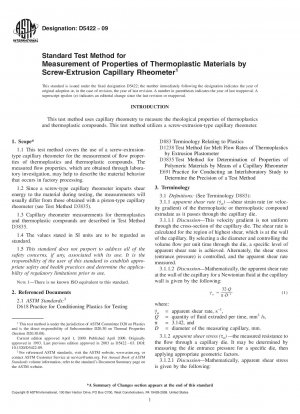ASTM D5422-09
Standard Test Method for Measurement of Properties of Thermoplastic Materials by Screw-Extrusion Capillary Rheometer
- Standard No.
- ASTM D5422-09
- Release Date
- 2009
- Published By
- American Society for Testing and Materials (ASTM)
- Status
- Replace By
- ASTM D5422-17
- Latest
- ASTM D5422-17
- Scope
This test method is useful for the characterization of thermoplastics and thermoplastic compounds, in terms of viscosity, or resistance to flow.
The data produced by this test method has been found useful in both quality-control testing and compound development. However, direct correlation with factory conditions is not implied.
Flow-performance data permits quality control of incoming thermoplastics and thermoplastic compounds because the flow parameters are sensitive to molecular weight and molecular-weight distribution. Therefore, this test method may distinguish differences between lots.
The shear viscosity or flow viscosity of thermoplastics and thermoplastic compounds will not only be sensitive to the raw-polymer molecular properties, but will also be affected by the type and amount of filler, additive, plasticizer, or stabilizer, by the type of copolymer blend, and by the addition of other compounding materials. This test method can serve as a quality-control tool for either incoming materials or for in-house quality-assurance checks on production mixing. This test method is useful to the research and development of new products in that the rheological behavior of a yet uncharacterized thermoplastic or thermoplastic compound can be measured and considered for comparative analysis.
1.1 This test method covers the use of a screw-extrusion-type capillary rheometer for the measurement of flow properties of thermoplastics and thermoplastic compounds. The measured flow properties, which are obtained through laboratory investigation, may help to describe the material behavior that occurs in factory processing.
1.2 Since a screw-type capillary rheometer imparts shear energy to the material during testing, the measurements will usually differ from those obtained with a piston-type capillary rheometer (see Test Method D 3835
). 1.3 Capillary rheometer measurements for thermoplastics and thermoplastic compounds are described in Test Method D 3835
. 1.4 The values stated in SI units are to be regarded as standard.
1.5 This standard does not purport to address all of the safety concerns, if any, associated with its use. It is the responsibility of the user of this standard to establish appropriate safety and health practices and determine the applicability of regulatory limitations prior to use.
Note 18212;There is no known ISO equivalent to this standard.
ASTM D5422-09 Referenced Document
- ASTM D1238 Standard Test Method for Flow Rates of Thermoplastics by Extrusion Plastometer
- ASTM D3835 Standard Test Method for Determination of Properties of Polymeric Materials by Means of a Capillary Rheometer
- ASTM D618 Standard Practice for Conditioning Plastics for Testing
- ASTM D883 Standard Terminology Relating to Plastics
- ASTM E691 Standard Practice for Conducting an Interlaboratory Study to Determine the Precision of a Test Method
ASTM D5422-09 history
- 2017 ASTM D5422-17 Standard Test Method for Measurement of Properties of Thermoplastic Materials by Screw-Extrusion Capillary Rheometer
- 2009 ASTM D5422-09 Standard Test Method for Measurement of Properties of Thermoplastic Materials by Screw-Extrusion Capillary Rheometer
- 2003 ASTM D5422-03 Standard Test Method for Measurement of Properties of Thermoplastic Materials by Screw-Extrusion Capillary Rheometer
- 2000 ASTM D5422-00 Standard Test Method for Measurement of Properties of Thermoplastic Materials by Screw-Extrusion Capillary Rheometer
